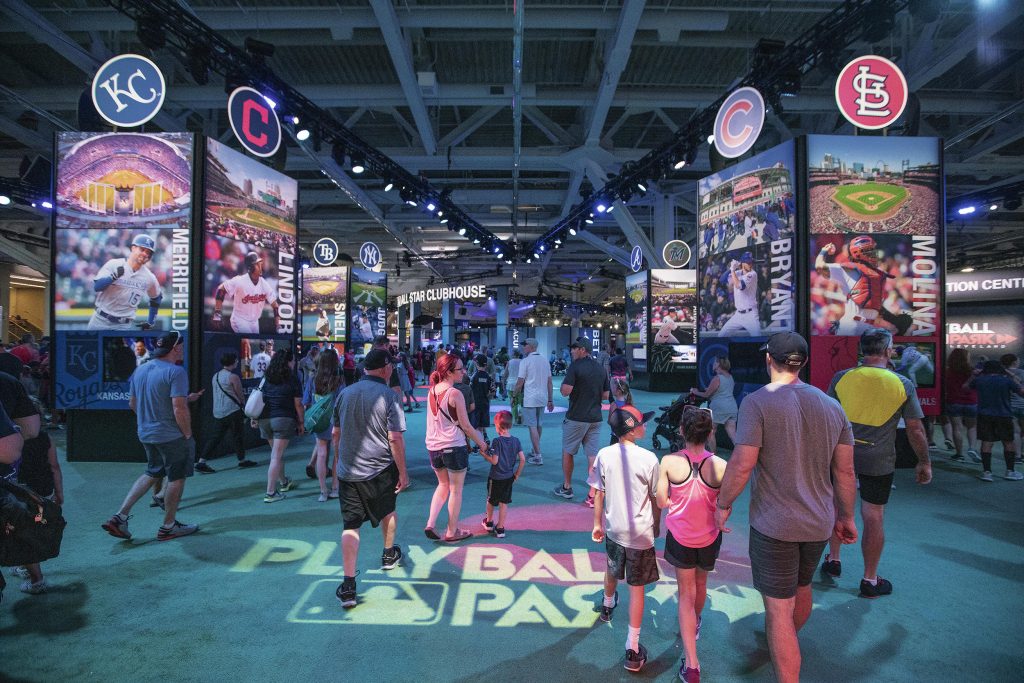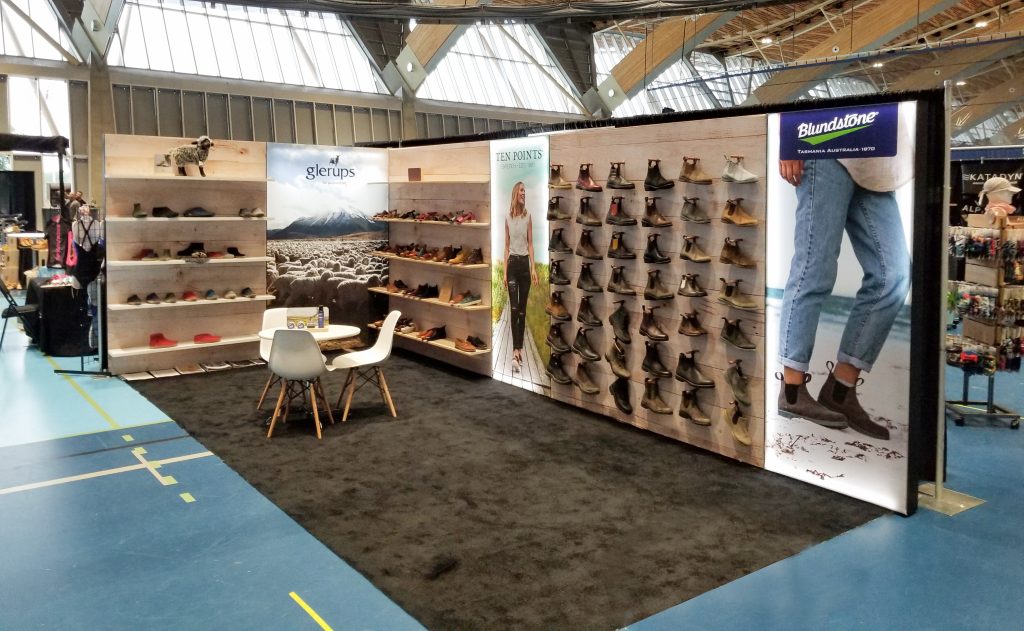
Features
Printing
Textile
Wide-format Inkjet
Dye-sublimation: Reasons to keep your eye on this growing market segment
January 30, 2020 By Katherine Hudon
 PNH Solutions printed dye-sublimated fabric banners on a Durst Rhotex for the MLB Play Ball Park, an exhibit dedicated to the league’s history, for the 2019 All-Star Game in Cleveland, Ohio. Photo: PNH Solutions
PNH Solutions printed dye-sublimated fabric banners on a Durst Rhotex for the MLB Play Ball Park, an exhibit dedicated to the league’s history, for the 2019 All-Star Game in Cleveland, Ohio. Photo: PNH Solutions Market intelligence and advisory firm Mordor Intelligence predicts the global dye-sublimation printing market will grow at a CAGR of 16.8 percent from 2020 to 2025. While the apparel and home textile segments will contribute to that growth, the increasing demand for soft signage for advertising purposes is expected to drive this market. With new and improved inks and print media, dye-sublimation printing – a digital printing process that uses heat to transfer dye to materials – is becoming the printing method of choice for brand owners.
Greater flexibility
Although screen printing offers similar print quality, it usually requires large minimum order quantities and tooling costs. With dye-sublimation, print service providers have greater flexibility to digitally produce one-offs at a fraction of the cost. As a result, brands can get on-demand, high-quality signage for time-sensitive promotions without having to commit to larger orders. Examples of soft signage using dye-sublimation include:
• Backlit banners, Silicone Edge Graphic (SEG) frames and lightboxes;
• Barricade and fencing covers;
• Construction hoarding;
• Fabric banners;
• Sampling counters and table covers;
• Tents and domes;
• Tension fabric displays;
• Umbrellas; and
• Window displays.
Dye-sublimated fabric can also be used to make custom products, such as pop-up retail displays or tradeshow exhibits, as the material can bend and stretch to fit any frame or structure.
Top-quality images
Instead of an inkjet printer’s individual dots and pixels, a dye-sublimation printer offers a continuous flow of colour, which produces clearer and brighter visuals.
Better durability
As the heat-sensitive inks transfer to the surface of the media, they become part of the material. Without dot or pixel patterns, the final product is more durable, as the ink doesn’t fade and the prints don’t damage easily, even after repeated uses and washes.
As a more durable product, dye-sublimation printing offers new opportunities for advertisers that want to use their products for an extended period of time. This is an especially attractive feature for brand managers looking for durable marketing products to refresh retail environments or to use as part of a long-term campaign that has multiple setups and teardowns.
With water-repellent print media and fade-resistant inks, dye-sublimated fabric can also be used to make promotional shelters (pop-up tents and domes), flags, umbrellas and outdoor media walls.
Ease of use
As the ink is embedded into the fabric rather than on the surface, dye-sublimated prints can be manipulated without the image fading or cracking.
Dye-sublimated fabric is easy to use, as it can be folded or rolled. While some print media options may need to be ironed or steamed after shipping, others – like fabric mesh – don’t crease and can be used as soon as they arrive onsite.
As practical and effective marketing products, Silicone Edge Graphic (SEG) fabric frames and lightboxes have been especially popular for retail displays and tradeshow exhibits. Due to the silicone beading, the dye-sublimated fabric print can be installed into the aluminum frame’s recessed groove easily and quickly without professional help. Claude Castonguay, Director of Research & Development at PNH Solutions, estimates that exhibitors can deduct about 25 percent from their total installation and decommission time when they use SEG fabric frames and lightboxes in their tradeshow booth compared to other finishing options, such as grommets, Velcro or pole pockets. Castonguay adds that silicone-edge beading also ensures the fabric banner remains taut, resulting in a cleaner, more professional finish.
Cost-effective
As a compact and lightweight material, dye-sublimated fabric is cost-effective, as it can be shipped in smaller packages, which helps organizations reduce their shipping, drayage and warehousing costs.
Beyond printing company names, logos and images, brand owners can mimic the look of heavier materials, such as wood or stone, using dye-sublimated fabric for their pop-up activations and tradeshow booths.
Wholesale shoe distributor Tin Shack used dye-sublimated fabric with wood panelling instead of real wood for a recent tradeshow booth campaign to reduce its shipping, drayage and warehousing costs. With a modular frame and compact materials, Tin Shack was able to fit the 10 x 20-foot tradeshow booth into two shipping crates, which helped to save on various costs throughout the job.

PNH Solutions designed, built and installed a 10 x 20-foot tradeshow booth for Tin Shack using backlit graphics (standing SEG fabric lightboxes) printed on a Durst Rhotex. Photo: PNH Solutions
Sustainability
Unlike screen printing, where large amounts of water is needed to dye the fabric, dye-sublimation doesn’t require water for dying, as the process involves turning colour into gas. As a result, dye-sublimation printing is considered the most environmentally-friendly, sustainable printing process for fabric that doesn’t contribute to waste water pollution and ground contamination.
Combined with water-based inks that are odourless and free of VOCs, dye-sublimation printing can use biodegradable polyesters as print substrates that are free of harmful substances, like heavy metals, toxic dyes, crop protection substances and carcinogenic substances, such as formaldehyde.
Conclusion
As a viable alternative to other forms of printing processes, it’s no surprise that dye-sublimation printing is growing in popularity. In addition to increased flexibility, dye-sublimated printing produces high-quality, durable and cost-effective marketing materials that are easy to manage and more sustainable to manufacture.
Katherine Hudon is Marketing Coordinator at PNH Solutions, a fully-integrated large-format print service provider and custom hardware supplier that specializes in turnkey marketing products for events, retail environments and tradeshows. Based in Montreal, Que., and Toronto, Ont., PNH completes projects all over the world.
This feature was originally published in the January/February 2020 issue of PrintAction, now available online.
Print this page